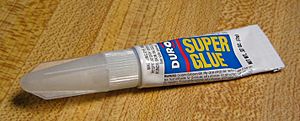Super glue facts for kids
Super glue, also known as cyanoacrylate, is a special type of very strong glue. It works super fast! You might know it by names like "Super Glue" or "Krazy Glue." This glue is used in many places, from homes to hospitals and even in factories.
Super glue is incredibly strong. Just a few drops can hold a lot of weight! But it's not as good at holding things if they are pulled sideways. There are also special kinds of super glue made for doctors and vets. These glues are safe to use on skin and don't cause irritation. Because it works so quickly, super glue is sometimes called "instant glue."
Contents
How Super Glue is Used
Super glue has many cool and important uses.
In Medicine and for Animals
Doctors and vets use super glue a lot. Long ago, in the 1970s, vets used it to fix bones, skin, and even tortoise shells! During the Vietnam War, a special super glue spray was used to stop bleeding in injured soldiers quickly. This helped them get to a hospital safely.
A type of medical super glue called Dermabond was approved for use on people's skin in the US in 1998. Studies have shown that super glue can be safer and work better than stitches for closing some wounds. However, it's not strong enough to replace all stitches and staples yet.
Some rock climbers use super glue to fix cuts on their fingertips. Musicians who play stringed instruments also use it to protect their fingers if their calluses (tough skin) wear off. While super glue isn't very harmful, putting a lot on your skin or breathing its fumes can cause mild burns.
Finding Fingerprints
Police and forensic scientists use super glue to find hidden fingerprints. They warm the glue to make fumes. These fumes react with the tiny bits of oil and sweat left behind by fingerprints. This reaction makes a white outline of the fingerprint appear, which can then be photographed and studied.
In Beauty Products
Super glue is also used in the beauty world! It's a common glue for fake nails and for attaching eyelash extensions. It's important to be very careful when using it near your eyes, as it can cause serious injury if it gets into them.
For Hobbies and Crafts
Many hobbyists love super glue because it's so versatile.
- People who build model aircraft or miniature models use it to put tiny parts together.
- It's great for fixing small electronics.
- Marine aquarium fans use it to attach coral pieces to rocks, helping them grow. It's safe to use directly in the water.
- In woodworking, thin super glue can create a shiny finish. It can also be mixed with sawdust to fill cracks in wood, like on piano soundboards or furniture.
- Some hobbyists mix super glue with baking soda to make it cure faster or create a stronger bond.
For Arrows and Fencing
- In archery, super glue is used to attach the fletching (feathers or plastic fins) to arrow shafts.
- In fencing, it helps glue the wire into the blade of an epee or foil.
Staying Safe with Super Glue
Super glue sticks very quickly to skin. You might accidentally glue your fingers together or to an object! If this happens, don't panic. You can use it to seal small cuts or scrapes, but never use it on deep or puncture wounds.
The glue can also cause mild chemical burns. If glue gets on your skin, wash it right away with soap and warm water. You can also try rubbing vegetable oil around the glued area to help loosen it.
If super glue gets in your eyes, it can cause serious harm. Rinse your eyes with lukewarm water for at least 15 minutes and get medical help immediately.
Be very careful with super glue around cotton materials like clothing, gloves, or cotton swabs. When super glue touches cotton, it can cause a strong reaction that creates heat and smoke. In some cases, it can even start a fire!
How to Remove Super Glue
If you get super glue where you don't want it, Acetone is a common helper. Acetone is found in many nail polish removers. It can soften hardened super glue. Other chemicals like nitromethane can also work. There are also special "debonder" products sold that are made to remove super glue.
How to Store Super Glue
Super glue doesn't last forever. It's best to keep it in a cool, dry place, like a refrigerator, before you open it. This can make it last longer, sometimes up to 15 months. Once you open a tube, it's best to use it within about 30 days. Don't put opened tubes back in the fridge.
If super glue gets old, it might become thicker and take longer to dry. Storing unopened glue in a freezer (around -4°F or -20°C) can make it last for a very long time, almost stopping it from getting old. Just remember to let it warm up to room temperature before you open it, so moisture from the air doesn't get inside.
Images for kids
See also
 In Spanish: Cianoacrilato para niños
In Spanish: Cianoacrilato para niños




